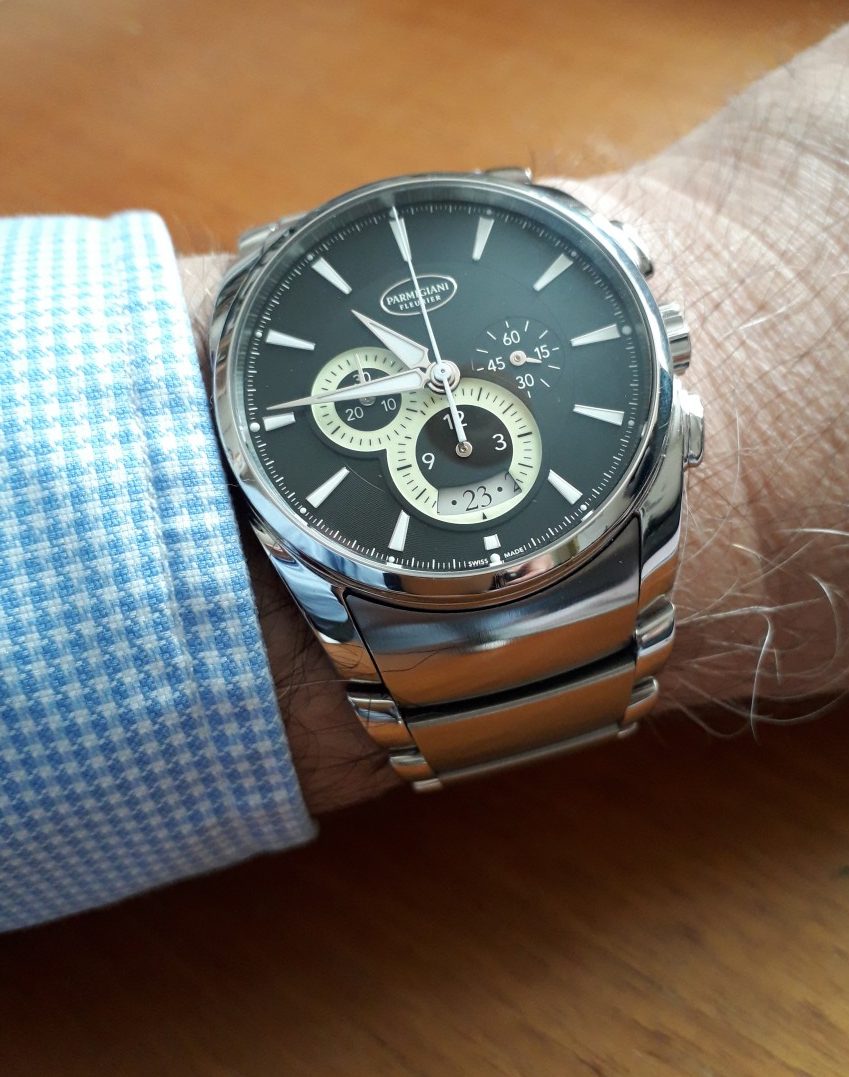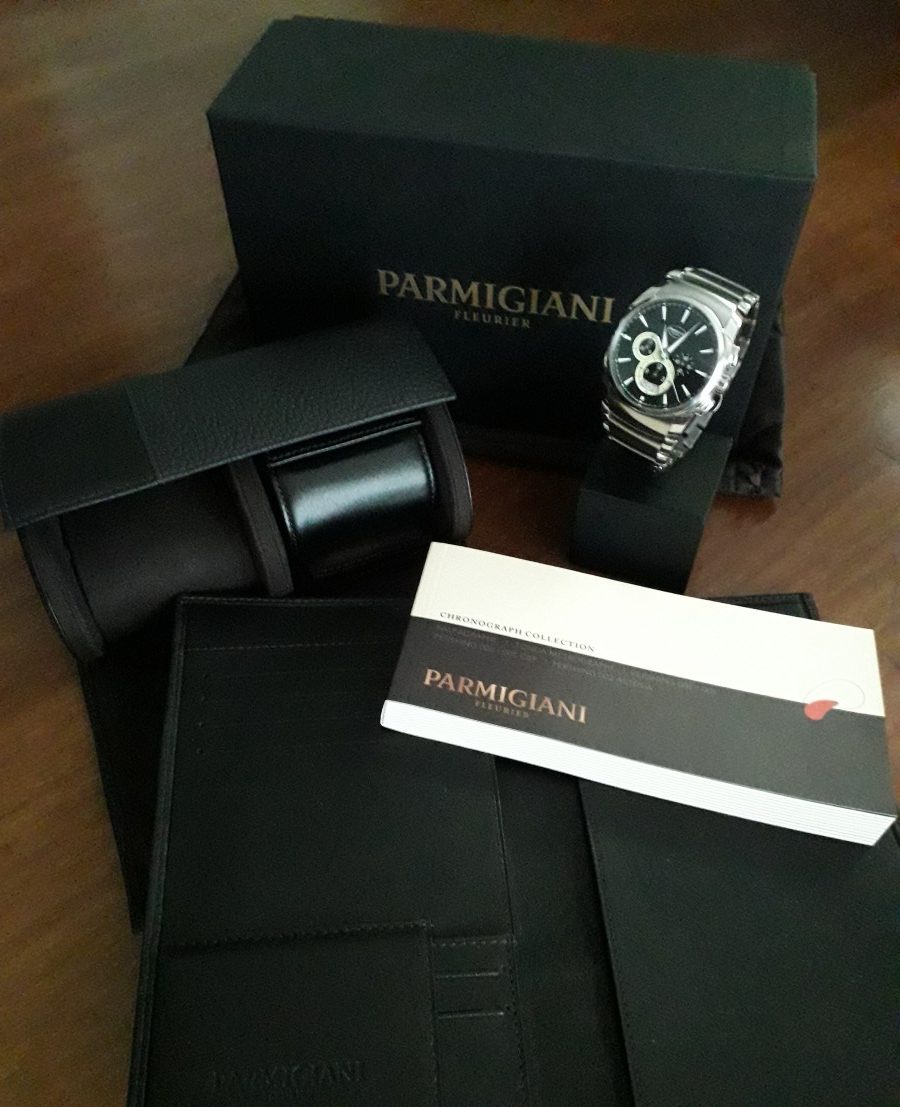I am including this watch in the “New Watch” section as although it has been out for a while now, it is still available.
If memory serves me, I think I first saw sight of this piece a few years ago in the now regrettably defunct QP magazine. So, proof that magazine articles do serve a brand’s marketing needs in that they can initiate a purchase (examples for me being a Czapek Faubourg de Cracovie the then a Tissot Ballard. Ed). The covered model had a black dial and generous green lume, along with probably the most organic bracelet I had seen for a long time – a little reminiscent of the “lobster” type fitted to the Omega Speedsonic in the early Seventies. I then put on the back burner until such time as I could view one in person, as it would be a fairly expensive outlay. I knew that Parmigiani had a boutique on Mount St so initially I thought that would have to wait for my next trip to London, as at the time there was no retailer in Manchester. In the meantime I could of course do more research on Parmigiani.

Peter Parmigiani qualified in the early Seventies as a watchmaker, opening his timepiece repair and restoration business in 1976. In 1978, the firm – now named “Parmigiani Mesure Et Art Du Temps” (PMAT), came to the attention of the Patek Phillip museum in Geneva. Such was the quality of his work they commissioned him to undertake work for them. On the back of this he then came to the attention of the Sandoz family who had a priceless collection of automatons and clocks. They asked him to maintain the collection and this eventually evolved into a collaboration with the Sandoz Family Foundation from which Parmigiani Fleurier was born in 1995, and the first Parmigiani watch was launched then. Over the course of the next six years the company evolved with a variety of specialist acquisitions and formations so that practically all required components could be sourced in-house (see Czapek article of July 2019 for more details. Ed) and this included Hermes who took a 25% stake in 2006. Parmigiani – along with Bovet, Chopard and Vaucher Manufacture Fleurier, also agreed a new quality and testing standard called Qualitie Fleurier. This not only equalled but superseded COSC’s requirements. The watches that Parmigiani have since produced, in fairly limited numbers, have been innovative, beautiful and on occasions complicated, and fall firmly within the haute horlogerie catergory. The Tonda Metrograph was launched in 2014 and I suppose this would be viewed as an “affordable” chronograph whilst still offering a high quality handmade timepiece.

Anyway, some six months later I was wandering past Chisholm Hunter in the Arndale Centre when I was brought up short. They now had a Parmigiani display with maybe six pieces – including the black dial Metrograph. This came as a surprise as, and I will try to be diplomatic, neither the location or retailer to my mind would have screamed haute horlogerie. Nonetheless, it served my needs very nicely, so I went in and took a closer look. I was impressed with the watch and It ticked most boxes. However, at that time I was quite interested in getting a blue-dial watch, and this was apparently available in this model (as was an Ivory coloured one). The salesperson mentioned that he thought that one of their Scottish branches had one so could get in for me. Within a week I was back and looking at the blue-dial version. Nice at it was, I noticed that oddly the prominent lume on the two sub-dials was now white, rather than green. I guess this was a purely an aesthetic choice from the designers, but for me this this really did not work as I felt it “cheapened” the dial somewhat. So, I reverted back to the black dial version which was still available, and after some more thought, decided to buy. One decision I had to then make was whether I stuck with the bracelet or opted for the alternative black Hermes deployant strap. At the time I opted for the former* as it was so interesting and nicely crafted.

As usual I tried my discount ploy as I had noticed that Parmiagiani had just upped their prices to now some £10,300, but was hoping CH had not noticed – they would have bought in at the lower price after all. Alas, this did not quite work out as they did know, and simply offered to sell at the original price – so some £9,600. On the one hand I benefited but on the other not!
So, what do we have? Well, a very attractive sports chronograph in stainless steel. The case diameter is 40 mm and 11.7 mm in thickness. The lugs seem to be attached to the case as opposed to be part of it, but nonetheless flow nicely from the case sides and morph into the bracelet well. The case and outer links are polished with an “escalator” look, with the centre portions brushed. The two timing pushers are subtle lozenge shapes and are actually positioned within the lugs – an unusual and attractive feature. The crown is attractive and is slightly lower than the pushers indicating a modular calibre. The case back has a sapphire crystal viewing window. Water resistance is to 30 meters.
Turning to the dial, this is jet black and has a second/minute track outboard. The hands are plated and delta shaped except for the second sweep which is a thin needle. White lume is on the main hands and the dots at the end of the dart shaped rhodium plated indexes. There are no time numerals. Turning to the sub-dials, at 3 there is the second counter in black with white numerals and snailing decoration. At 6 is the hour counter – again in black with snailing, but with a bold green lumed outer ring. In the lower portion of this dial is a cut out segment for the date wheel. At 9 is the minute counter – with a black inner portion but again showing a green lumed outer portion. Both the latter two dials intersect so the effect shows a tilted numeral 8. All this is protected by an anti-reflective sapphire crystal.

Turning to the motivation, this is Parmigiani’s PF315 movement. It beats at 4 HZ (28,800 vph) and has a power reserve of 42 hours, generated by two barrels. There are 351 components and 46 jewels. The movement actually uses the in-house Vaucher base PF331, but with a chronograph module from Dubois-Depraz. So, much of the watch is fabricated and built by Vaucher or associated Parmigiani ateliers. To be noted is the fact that Vaucher were working at the same time on a totally integrated chronograph movement for Parmigiani which came out in 2015 (approx) and installed in their Kalpagraph. This movement basis was also used in Czapek’s first chronograph – the Faubourg de Cracovie in 2017, albeit with some modifications (see Czapek article of July 2019 for more details. Ed)

In conclusion, this is a top quality, functional, and attractive watch from a leading haute horlogerie maison with an interesting history. Additionally, although in some aspects they are not that expensive, they are still pretty exclusive so you will rarely bump into another wearer – even at a watch do! Well, unless you mingle with Prince Charles who is a fan and has a lovely gold Toric Chronograph. The price, for what you get, is I feel very good – unless you want a strap*.

After owning the watch for a few months, I did ponder trying it on a strap. Why? Well, overall, there is a fair chunk of steel here all told and so it does feel a bit hefty. I had seen pictures on the black deployant strap and it looked pretty good. Anyway, when I enquired about obtaining one I was informed that the whole thing would be a whopping £800 odd. Well, the leather was Hermes I suppose! In the end I decided not to risk getting it then not liking it, so decided to obtain an after-market strap first. In the end I selected a good quality pin buckle alligator/calf version from Hirsch. I have to confess that I do prefer it on a strap and kind of now wished I had made this choice on purchase. That said, I still think the bracelet is a thing of beauty – if only it had been made from Titanium! By the way, changing the bracelet to strap and vice versa is rather a pain and very fiddly so undertake with caution. So, for the article I have just retained the bracelet and sourced an image from the internet for a strap version.

And finally, the overall attention to detail extends to the box and accompaniments. Included is a very nice leather twin watch roll with an inner removable leather single travel roll. In addition, a large beautiful grained leather wallet – yes, a proper wallet for putting money, cards and what-not in! These alone I would guess retail at £200-£300 so the overall watch cost seems even better!

Rating: 4.5/10 (would have got a 5 if a little lighter!)
Words/Pictures: The Writer (except for strap image – sourced from the internet – anon)

